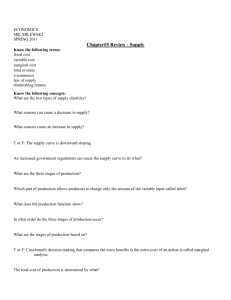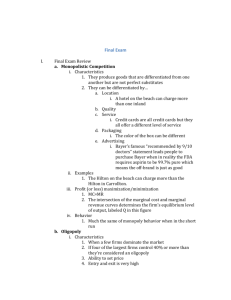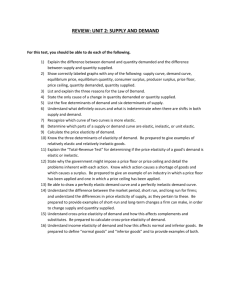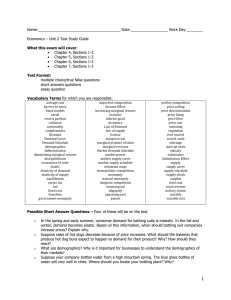supply
advertisement
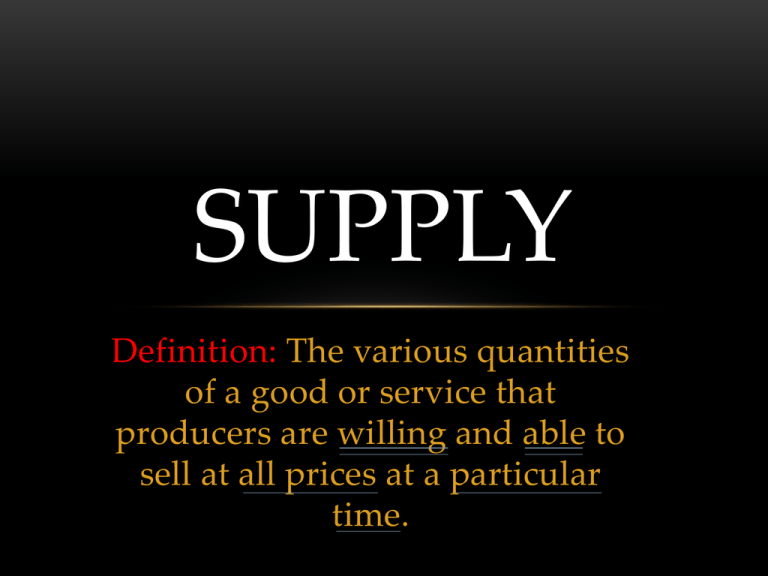
SUPPLY Definition: The various quantities of a good or service that producers are willing and able to sell at all prices at a particular time. WHY DO PRODUCERS PRODUCE? Two Words. Profit Motive. **Remember the invisible hand? Demand drives Supply… LAW OF SUPPLY • As P ↑, QS ↑ • As P ↓, QS ↓ • Opposite of the law of demand • Why? Example… Mr. Bull’s Soccer Lessons How many lessons might I give if I was able to charge….. $5/hr? $15/hr? $40/hr? As I am able to charge more, production becomes more valuable relative to other tasks. What is my opportunity cost of soccer lessons? SUPPLY SCHEDULE/CURVE • Notice… opposite of Demand curve • Upsloping • Individual Supply vs. Market Supply THE LAW OF SUPPLY Reasons for a Change in Quantity Supplied: (Always associated with a change in a product’s own price) 1. Assuming firms’ costs are constant, at higher prices, producers make more profits. - Economies of Scale 2. When prices rise, firms substitute production of one good for another. Change in Quantity Supplied: Movement along the Supply Curve Price (per unit) S0 B $15 A Change in quantity supplied (a movement along the curve) 1,250 2,300 Quantity supplied (per unit of time) SHIFTS IN SUPPLY VERSUS MOVEMENTS ALONG A SUPPLY CURVE If the amount supplied is affected by anything other than a change in price, there will be a shift in supply. Shift in Supply S0 Price (per unit) S1 $15 A B Shift in Supply (a shift of the curve) 1,250 2,300 Quantity supplied (per unit of time) 7 REASONS FOR A CHANGE IN SUPPLY 1. Change in the cost of inputs • Land, labor, capital 2. Change in Productivity 3. Change in Technology • Ask Henry Ford… 4. Change in Number of Sellers • Duh. 7 REASONS FOR A CHANGE IN SUPPLY 5. Change in Taxes or Subsidies 6. Change in Market Expectations • Future prices/demand/conditions 7. Change in Government Regulation “Government's view of the economy could be summed up in a few short phrases: If it moves, tax it. If it keeps moving, regulate it. And if it stops moving, subsidize it.” -Ronald Reagan ELASTICITY OF SUPPLY • Elastic – easy/quick to produce – lower marginal cost for each additional unit produced • Inelastic – harder/slower to produce – higher marginal cost for each additional unit produced • Elasticity of supply increases as producers have more time to adjust to a price change • Ex: 1979 2011 FACTORS AFFECTING ELASTICITY OF SUPPLY 1. Ease of Production easier = more elastic 2. Responsiveness to price change quicker adjustment = more elastic 3. Time more time to adjust = more elastic ELASTICITY CHANGES OVER TIME • Market Period – immediately after a change in price • Perfectly inelastic supply • Short Run – up to a few months after a change in price • Inelastic supply • Long Run – many months/years after a price change • Elastic supply PROFIT MAXIMIZATION • Profit = Total Revenue - Total Cost • Total Cost = Fixed Cost + Variable Cost • Fixed vs. Variable… examples? • Fixed – rent, loan payments, utilities • Variable – labor, raw materials • Firms want TR > TC… • But how do they maximize this profit? • MARGINAL ANALYSIS!!!! PROFIT MAXIMIZATION • Marginal Cost = ∆ Price of Inputs / ∆ Output MC = ∆ Variable Cost/ ∆ Quantity • Marginal Revenue = Price • Profit Maximization: As long as MR > MC, producers will continue to produce. Production Function.notebook TEST TOPICS • Definition/Law of Supply • Supply Curve • Market Supply • Change in Supply • 7 factors • Elasticity of Supply • 3 factors • 3 Stages of Production • Profit Maximization • MR = MC




